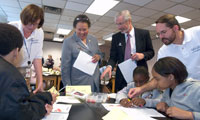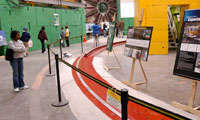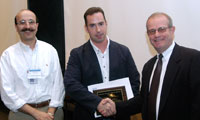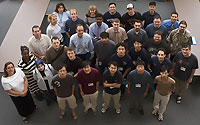2006 News Release
Our greatest advantage in the world has always been our educated, hardworking, ambitious people -- and we're going to keep that edge. Tonight I announce an American Competitiveness Initiative, to encourage innovation throughout our economy, and to give our nation's children a firm grounding in math and science." President George W. Bush, State of the Union Address, January 31, 2006.
Fueling Technological Innovation
K-12, Undergraduate, and Public Science Education Efforts At Jefferson Lab

Former Virginia Secretary of Education Dr. Belle Whelan visited JLab in the fall of 2004 to learn about the range of education programs conducted here. Pictured: Lab Director Christoph Leemann (right), watches while BEAMS volunteer Joyce Miller (left) and Steve Gagnon, Science Education technician (far right) assist students.
Jefferson Lab's Science Education Office was established in 1991. The many programs offered by Science Education, staffed by just six people, have directly impacted over 100,000 young people in its short history. According to Science Education Manager Jan Tyler, Becoming Enthusiastic About Math and Science (BEAMS) is the largest program.
"We work with inner-city schools in Newport News. These are students that typically score below average on standardized test scores. We've looked at the standards and the science we do at the Lab, and we've used the standards and the science to make hands-on activities for the students to do while they're here," Tyler says.
About 1,500 students participate in the program each year, with students coming to the Lab in the sixth grade and eighth grades. Results from Virginia standardized test scores show that BEAMS is helping to close the scoring gap between traditionally low-scoring and average-scoring schools. "We've seen increases of anywhere between 15 to 20 points in math and in science," Tyler notes.
An added benefit of the program is the informal mentoring students receive from Lab volunteers. "The activities are led by Lab staff. So whenever the students come to the Lab, they get to interact with different people from different careers and different backgrounds," she says.
Two other programs are geared toward young adults. The HSSHP (High School Summer Honors Program) allows high school students to participate in scientific or technical activities in directed projects for eight weeks during the summer. Students chosen for these positions are interested in pursuing scientific and technical careers. In the Department of Energy (DOE)-sponsored Science Undergraduate Laboratory Internships (SULI), students work with scientists or engineers on projects related to JLab's research programs. Students in both programs present their project in a poster session; and SULI students' papers on their work may be chosen for publishing in an undergraduate science journal.

Other, more informal educational opportunities include the Science Series, informative lectures or demonstrations given by guest speakers on current science topics. There is also a biennial Open House, shown here, science demonstrations at the Virginia State Fair, Career Day school visits, and public presentations to community groups.
Science Education also offers programs for teachers. The Teacher Academy for the Physical Sciences (TAPS) is a four-week basic refresher course in physics and chemistry for middle school science teachers. In the summer of 2005, 17 teachers participated in the program, which helps teachers improve their knowledge of the subject areas they're teaching. "For instance, in 2004, in the physics course, teachers average scores went from 62% to 80%. And in the chemistry course, teachers average score went from 58% to 87%," Tyler says.
Another program sponsored by DOE, the Pre-Service Teacher program, places participants in paid internships in science, math and technology at the Lab. Program participants have decided on a teaching career in one of these disciplines and spend the summer before entering the workforce with scientists or engineers on projects related to JLab's research program.
These programs are all geared to help prepare students and young adults to succeed in math and science and to enter the pipeline to a rewarding career in a technical field. "So between the undergraduates and the high school kids and working with the teachers, we're hoping to fill this pipeline," Tyler says.
The Lab also hosts two DOE Science Bowl competitions - one for high school students and another for middle school. "The Department of Energy's been doing a Science Bowl since 1991. It's sort of a Jeopardy-based science game," Tyler says.
The winner of the High School competition goes on to compete at the National Science Bowl in Washington, D.C. For the past four years, the winner of the Lab-hosted Virginia Regional Science Bowl -- Thomas Jefferson High School in Alexandria, Va. -- has gone on to win the national competition. Middle school winners go on to compete in the National Middle School Science Bowl at the National Renewable Energy Laboratory in Golden, Co.
Finally, Science Education's web pages are the most frequently accessed on Jefferson Lab's web site. "In 2001, 9.1 million pages were accessed, and in 2005, 121 million pages were accessed or downloaded," Tyler says. The practice Virginia Standards of Learning (SOL) standardized test pages, in particular, have received more than a half-million hits on some days, as parents and teachers help students study for the exams.
Higher Education Efforts At Jefferson Lab
The Lab is also a major participant in the education of graduate students who have chosen to study nuclear, accelerator or other Lab-related sciences. Those students meet Robert (Bob) Welsh, Chancellor Professor of physics at the College of William & Mary (William & Mary) and the head of JLab's Student Affairs Office, on their very first visit.
"Every student who arrives here is scheduled to have an interview with me," Welsh says, "I do what I can to assist them; I find out if they have housing and transportation and I try to inform them of opportunities available to graduate students in this area."

Karl Slifer (center), UVA, accepts the Southeastern Universities Research Association Thesis Prize from SURA President Jerry Draayer. They are accompanied by JLab user, Zein-Eddine Meziani (Temple University), who was Slifer's advisor at Temple.
Welsh notes that there are several programs in place to assist graduate students at the Lab. He annually participates in the selection process for the students chosen for two of these programs, which are sponsored by the Southeastern Universities Research Association (SURA). One is the SURA/Jefferson Lab Graduate Fellowship Program. The program offers seven yearly fellowships equal to one-half of a research assistant's university stipend plus $2,000 and a travel allowance of $2,000 (the home university of the applicant pays the other half of the stipend). The SURA Thesis Prize is an annual award given in recognition of the vital role played by graduate students in the scientific mission of Jefferson Lab. Established in 1999, the prize is awarded annually for the best graduate student thesis and includes a stipend of $1000 and a commemorative wall plaque. The award is presented at the annual Users Group meeting each June where the winner gives a talk to the entire JLab community.
Welsh says the office also provides other assistance to graduate students. "There's a wide range of things I find myself doing. I am present in lieu of absent advisors, so that if an advisor needs a student to be helped or if a student needs an interim 'advisor', they can call on me," Welsh says.

The Hampton University Graduate Studies Summer School (HUGS) is a program at Hampton University and Jefferson Lab designed for second and third year experimental or theoretical Nuclear/Particle physics Ph.D. students. The program, which lasts for three weeks and serves as a crash course in JLab physics, celebrated its 20th anniversary in 2005. Seen here is the HUGS class of 2005 and HUGS instructors and administrators.
As part of his responsibilities, Welsh arranged for a student lounge, a volleyball court and summer picnics. He also initiated the famous Jlab graduate student pizza lunches. "Because the students want to meet one another, and the students benefit by giving talks to one another, and this was a way to do that. I think those have been pretty successful at modest cost," Welsh says.
He recently served as the Jlab representative on the DOE/National Science Foundation Nuclear Science Advisory Committee's Subcommittee on Education. It was charged with broadly assessing "how the present NSF and DOE educational investments relevant to nuclear science are being made" and with identifying "key strategies for preparing future generations of nuclear physicists and chemists." The committee found that in nuclear science, more than three-quarters of the workforce in nuclear engineering and at the national laboratories will reach retirement age in the next ten years.
An agreement he recently negotiated between Jlab and William & Mary allows Jefferson Laboratory graduate students from out-of-state who are participating in research projects at the Lab to take physics courses at in-state tuition rates. Credits for these courses transfer to the students' home institution, allowing students to come to the Lab earlier and potentially to finish their Ph.D. faster. This is one way to help speed students out of the pipeline and into the workforce. The tuition fees thus result in a net increase to the state while the results advance research at the laboratory as well.
However, it's clear that JLab makes a major contribution to the education of future nuclear physicists. "We have nearly 200 students whose research is associated with the existence of Jefferson Lab," Welsh says, and JLab research results in about 25% of the nuclear science doctoral degrees awarded each year by US colleges and universities.
More information:
- Science Education Office
- Student Affairs Office
- Rising Above The Gathering Storm: Energizing and Employing America for a Brighter Economic Future
- Education in Nuclear Science: A Status Report and Recommendations for the Beginning of the 21st Century
Thomas Jefferson National Accelerator Facility’s (Jefferson Lab’s) basic mission is to provide forefront scientific facilities, opportunities and leadership essential for discovering the fundamental structure of nuclear matter; to partner in industry to apply its advanced technology; and to serve the nation and its communities through education and public outreach. Jefferson Lab, located at 12000 Jefferson Avenue, is a Department of Energy Office of Science research facility managed by the Southeastern Universities Research Association.

